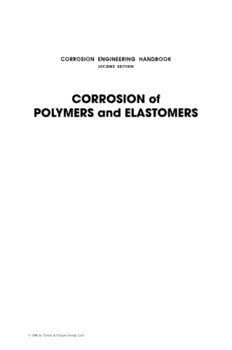
Corrosion of Polymers and Elastomers PDF
Preview Corrosion of Polymers and Elastomers
q2006byTaylor&FrancisGroup,LLC q2006byTaylor&FrancisGroup,LLC q2006byTaylor&FrancisGroup,LLC Preface Corrosionisbothcostlyanddangerous.Billionsofdollarsarespentannually for the replacement of corroded structures, machinery, and components, includingmetalroofing,condensertubes,pipelines, andmanyother items. In addition to replacement costs are those associated with maintenance to prevent corrosion, inspections, and the upkeep of cathodically protected structures and pipelines. Indirect costs of corrosion result from shutdown, loss of efficiency, andproduct contamination or loss. Althoughtheactualreplacementcostofanitemmaynotbehigh,theloss ofproductionresultingfromtheneedtoshutdownanoperationtopermit thereplacementmayamounttohundredsofdollarsperhour.Whenatank orpipelinedevelopsaleak,productislost.Iftheleakgoesundetectedfora period of time, the value of the lost product could be considerable. In addition, contamination can result from the leaking material, requiring cleanup, and this can be quite expensive. When corrosion takes place, corrosion products build up, resulting in reduced flow in pipelines and reduced efficiency of heat transfer in heat exchangers. Both conditions increaseoperatingcosts.Corrosionproductsmayalsobedetrimentaltothe quality of the product being handled, making it necessary to discard valuable materials. Premature failure of bridges or structures because of corrosion can also resultin human injury oreven loss of life. Failuresof operating equipment resultingfrom corrosioncan have the same disastrousresults. When all of these factors are considered, it becomes obvious why the potentialproblemofcorrosionshouldbeconsideredduringtheearlydesign stages of any project, and why it is necessary to constantly monitor the integrity of structures, bridges, machinery, and equipment to prevent prematurefailures. To cope with the potential problems of corrosion, it is necessary to understand 1. Mechanisms of corrosion 2. Corrosion resistant propertiesof variousmaterials 3. Properfabrication and installation techniques 4. Methods to preventorcontrolcorrosion 5. Corrosion testing techniques 6. Corrosion monitoring techniques Corrosionisnotonlylimitedtometallicmaterialsbutalsotoallmaterials of construction. Consequently, this handbook covers not only metallic materialsbut alsoall materialsof construction. q2006byTaylor&FrancisGroup,LLC Chapter 1 through Chapter 4 covers polymeric (plastic) materials, both thermoplastic and thermoset. An explanation is presented as to the type of corrosive effects of each polymer, its ability to withstand sun, weather, and ozone,along with compatibility tables. Chapter5andChapter6coverelastomericmaterialsinthesamemanner that polymers are coveredin Chapter 1throughChapter 4. It is the intention of this book that regardless of what is being built, whether it be a bridge, tower, pipeline, storage tank, or processing vessel, informationforthedesigner/engineer/maintenancepersonnel/orwhoever is responsible for the selection of material of construction will be found in this book to enable them to avoid unnecessary loss of material through corrosion. Philip A.Schweitzer q2006byTaylor&FrancisGroup,LLC Author Philip A. Schweitzer is a consultant in corrosion prevention, materials of construction, and chemical engineering based in York, Pennsylvania. A formercontractmanagerandmaterialspecialistforChem-ProCorporation, Fairfield, New Jersey, he is the editor of the Corrosion Engineering Handbook and the Corrosion and Corrosion Protection Handbook, Second Edition; and the author of Corrosion Resistance Tables, Fifth Edition; Encyclopedia of Corrosion Technology, Second Edition; Metallic Materials; Corrosion Resistant Linings and Coatings;AtmosphericDegradationandCorrosionControl; What Every Engineer Should Know About Corrosion; Corrosion Resistance of Elastomers; Corrosion Resistant Piping Systems; Mechanical and Corrosion Resistant Properties of PlasticsandElastomers(alltitlesMarcelDekker,Inc.),andPaintandCoatings, Applications andCorrosion Resistance(Taylor &Francis).Schweitzer received the BChE degree (1950) from Polytechnic University (formerly Polytechnic Institute of Brooklyn),Brooklyn, NewYork. q2006byTaylor&FrancisGroup,LLC q2006byTaylor&FrancisGroup,LLC Contents Chapter1 Introduction toPolymers.............................................................. 1 1.1 Additives....................................................................................................... 5 1.2 Permeation.................................................................................................... 6 1.3 Absorption.................................................................................................. 12 1.4 Painting of Polymers................................................................................. 15 1.5 Corrosionof Polymers.............................................................................. 16 Chapter2 Thermoplastic Polymers............................................................. 19 2.1 Joining of Thermoplastics......................................................................... 30 2.1.1 Use ofAdhesive.......................................................................... 32 2.2 Acrylonitrile–Butadiene–Styrene(ABS)................................................. 37 2.3 Acrylics........................................................................................................ 37 2.4 Chlotrifluoroethylene (CTFE).................................................................. 41 2.5 Ethylenechlorotrifluoroethylene (ECTFE).............................................. 46 2.6 Ethylene Tetrafluoroethylene (ETFE)...................................................... 51 2.7 Fluorinated Ethylene–Propylene (FEP).................................................. 51 2.8 Polyamides(PA)......................................................................................... 60 2.9 Polyamide–Imide (PAI)............................................................................. 65 2.10 Polybutylene (PB)...................................................................................... 66 2.11 Polycarbonate (PC).................................................................................... 68 2.12 Polyetheretherketone(PEEK)................................................................... 70 2.13 Polyether–Imide(PEI)............................................................................... 73 2.14 Polyether Sulfone (PES)............................................................................ 75 2.15 Perfluoralkoxy (PFA)................................................................................. 77 2.16 Polytetrafluoroethylene (PTFE)............................................................... 81 2.17 PolyvinylideneFluoride (PVDF)............................................................. 82 2.18 Polyethylene (PE)....................................................................................... 91 2.19 Polyethylene Terephthalate (PET)......................................................... 100 2.20 Polyimide (PI)........................................................................................... 102 2.21 Polyphenylene Oxide (PPO).................................................................. 103 2.22 Polyphenylene Sulfide(PPS).................................................................. 104 2.23 Polypropylene (PP).................................................................................. 108 2.24 Styrene–Acrylonitrile(SAN).................................................................. 113 2.25 PolyvinylideneChloride (PVDC).......................................................... 114 2.26 Polysulfone (PSF)..................................................................................... 118 2.27 Polyvinyl Chloride (PVC)....................................................................... 121 2.28 Chlorinated Polyvinyl Chloride(CPVC)............................................. 129 2.29 Chlorinated Polyether (CPE)................................................................. 134 q2006byTaylor&FrancisGroup,LLC 2.30 Polyacrylonitrile (PAN)......................................................................... 134 2.31 Polyurethane(PUR)............................................................................... 138 2.32 Polybutylene Terephthalate (PBT)...................................................... 141 2.33 Acetals...................................................................................................... 143 References.......................................................................................................... 146 Chapter 3 Thermoset Polymers.................................................................. 147 3.1 Corrosionof Thermosets........................................................................ 147 3.2 Joiningof Thermosets............................................................................. 151 3.3 Ultraviolet Light Stability....................................................................... 151 3.4 ReinforcingMaterials.............................................................................. 151 3.4.1 GlassFibers................................................................................ 152 3.4.1.1 E Glass......................................................................... 152 3.4.1.2 CGlass......................................................................... 152 3.4.1.3 SGlass.......................................................................... 154 3.4.1.4 Glass Filaments.......................................................... 154 3.4.1.5 ChoppedStrands....................................................... 155 3.4.1.6 Glass Mats................................................................... 155 3.4.1.7 Glass Fabrics............................................................... 155 3.4.2 Polyester..................................................................................... 155 3.4.3 Carbon Fiber.............................................................................. 156 3.4.4 Aramid Fibers............................................................................ 156 3.4.5 Polyethylene Fibers.................................................................. 157 3.4.6 Paper........................................................................................... 157 3.4.7 Cotton andLinen...................................................................... 158 3.5 Polyesters.................................................................................................. 158 3.5.1 GeneralPurpose Polyesters.................................................... 160 3.5.2 Isophthalic Polyesters............................................................... 161 3.5.2.1 Typical Applications.................................................. 165 3.5.3 Bisphenol AFumaratePolyesters.......................................... 166 3.5.3.1 Typical Applications.................................................. 173 3.5.4 Halogenated Polyesters........................................................... 173 3.5.4.1 Typical Applications.................................................. 178 3.5.5 TerephthalatePolyesters (PET)............................................... 178 3.5.5.1 Typical Applications.................................................. 180 3.6 Epoxy Polyesters...................................................................................... 180 3.6.1 Resin Types................................................................................ 181 3.6.2 Curing......................................................................................... 182 3.6.2.1 AromaticAmines....................................................... 183 3.6.2.2 Aliphatic Amines....................................................... 183 3.6.2.3 Catalytic Curing Agents........................................... 183 3.6.2.4 Acid Anhydrides....................................................... 183 3.6.3 CorrosionResistance................................................................ 184 3.6.4 Typical Applications................................................................. 184 3.7 VinylEsters............................................................................................... 188 q2006byTaylor&FrancisGroup,LLC
